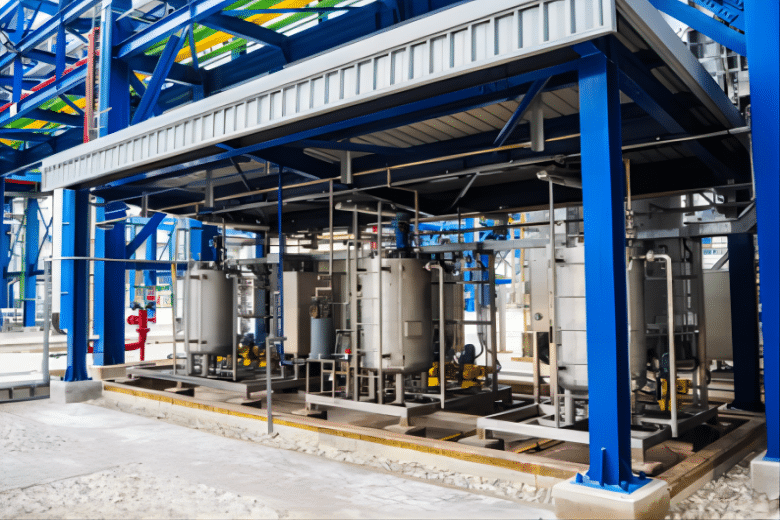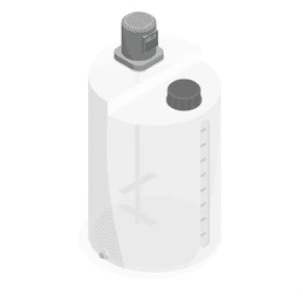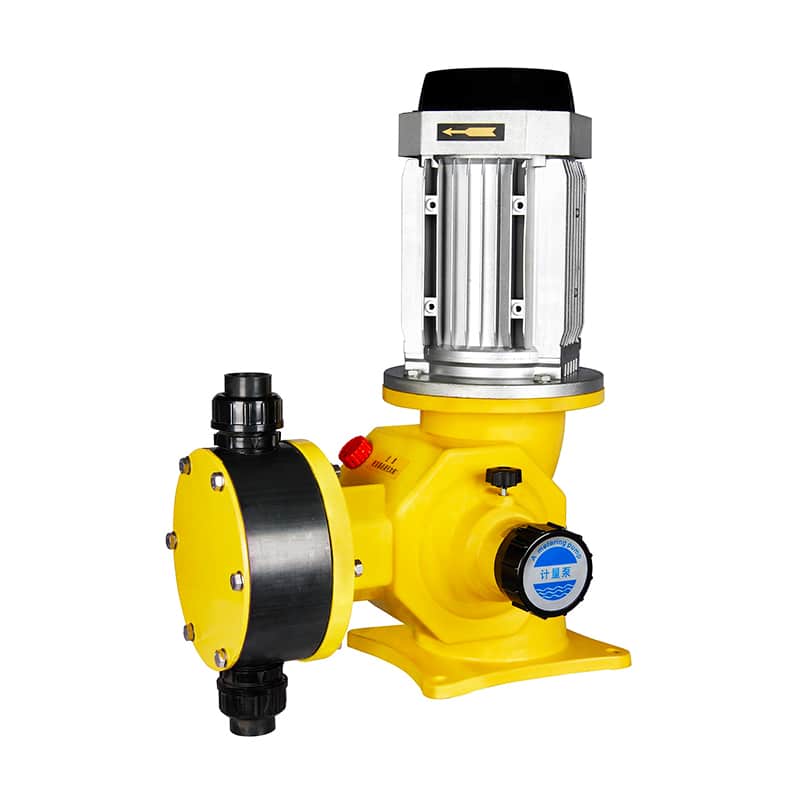What Is A Dosing Tank?

Dosing tanks are an important piece of equipment in the field of water treatment, used to ensure that chemicals are stored, mixed and accurately delivered for water quality adjustment and treatment.
What is a dosing tank?
Dosing tank is a kind of container specialized for storing, mixing and adding chemicals, usually used in water treatment, waste water treatment, environmental engineering and other fields. Dosing tanks can be designed and manufactured in different materials, capacities and forms according to different needs and applications.

Characteristics of dosing tank
- Materials: Dosing tanks can be manufactured using a variety of materials, the most common of which include polyethylene (PE) and polypropylene (PP). These materials are usually resistant to corrosion, chemicals and pressure to ensure safe storage and filling of chemicals.
- Capacity: The capacity of dosing tanks can vary according to the need, ranging from tens of liters for small ones to thousands of liters for large ones. Different applications require different amounts of storage and frequency of delivery, so the capacity of the dosing tank will be adjusted.
- Shape: There are many different shapes of dosing tanks to choose from, with common shapes including vertical and horizontal. Vertical dosing tanks are suitable for places with limited space, while horizontal dosing tanks can be better adapted to some special scenarios.
Structure of dosing tanks
- Dosing Pump: The dosing pump is a key device for accurately delivering chemicals from the dosing tank into the treatment system. Dosing pump can be preset according to the flow rate and the proportion of pharmaceutical delivery to ensure that the water quality of the precise adjustment.
- Valves: Valves are used to control the flow and stopping of chemicals, as well as to adjust the flow and pressure of the delivery. Valves can be manually operated or automatically controlled to make the dosing process more accurate and controllable.
- Flow Meter: The flow meter is used to monitor and measure the flow rate of the chemical to ensure accurate delivery of the chemical. Flow meter can help the operator to understand the real-time situation of the drug delivery, and make the necessary adjustments.
- Level Gauge: The level gauge is used to monitor the level of the chemical in the dosing tank to ensure that an adequate supply of chemical is maintained at all times. The level gauge can help the operator to understand the situation of the stored chemicals, to avoid the occurrence of insufficient chemicals.
- Control system: The dosing tank is usually equipped with chemical dosing system, used to monitor and control the dosing pumps, valves, flow meters and other equipment. The control system can realize the automation of the drug delivery, improve the convenience and accuracy of the operation.
- Agitator: Some dosing tanks may be equipped with an agitator for mixing the chemicals stored in the dosing tank to maintain uniform distribution and stability of the chemicals.
- Connecting pipes and joints: The dosing tank is connected to the dosing system by connecting pipes and joints to ensure a smooth flow of the chemical to the area to be treated.
- Pulse dampeners: Pulse dampeners are used to reduce the pressure pulsations generated by chemical feed pumps. This helps protect the pump and process stream from damage.
Workflow of dosing tank
Dosing tanks are a key part of water treatment and are primarily used to add necessary chemicals to the water.
- Pharmaceutical storage: First, there needs to be a place to store the chemicals that are going to be used, this is usually a large storage tank or container. These systems are typically used to store and automatically meter liquid chemicals.
- Metering pumps/devices: In order to ensure that the right amount of chemical is added, proportioning pump or other metering devices are used to accurately control the flow of chemicals.
- Addition of water flow: The flocculant is injected into the dosing tank through the metering pump/device and mixed with the water entering the dosing tank.
- Agitation and mixing: Inside the dosing tank, there is usually an agitator or other mixing device to ensure that the chemical is well mixed and evenly dispersed with the water.
- Reaction Time: Allows the chemical to fully react with contaminants or other components in the water. This step may require a specific residence time to ensure completion of the desired chemical reaction.
- Exit to next treatment step: After proper mixing and reaction, the treated water flows to the next treatment unit, such as a flocculation or settling tank.
- Monitoring and Adjustment: Sensors or sample sampling are used to monitor the quality of the dosed water and adjust the dosage of chemicals as needed.
How to choose pump for a dosing tank?
Pumps are designed for precise, continuous delivery of liquids to dosing tanks or other applications. Based on their operating principle and design, pumps can be categorized into the following major types:
- Diaphragm metering pump: These pumps use a flexible diaphragm that sucks in and discharges liquid through repeated movements. The movement of the diaphragm is usually driven by a motor or gas. The mechanical metering pump is an excellent choice.
- Plunger metering pumps: These pumps use a plunger that moves back and forth in a cylinder, similar to the piston in an automobile, and draws in and discharges liquid through this action.
- Peristaltic Pump: This pump uses a continuous hose to move liquid by compressing the hose. As one section is compressed, the liquid is pushed into the next section, producing a continuous flow.
- Screw pumps: Screw pumps move liquid through one or more pairs of interlocking screws. They provide highly accurate flow control.
- Rotary Metering Pumps: These pumps transfer liquid from one port to another through the rotation of a rotor and the interaction with its corresponding stator.
- Solenoid Dosing Pump: These pumps use the electromagnetic principle to drive a diaphragm and have no dynamic seals, thus reducing the possibility of leakage. The H series for dosing liquid media in water treatment and chemical processes. Cost-effective, overload-proof and adaptable to existing signal sensors.


Advantages and disadvantages of dosing tanks
| Advantages | Disadvantages |
| Provides centralized storage | Need for space |
| Flexibility | Material compatibility |
| Control precision | Maintenance costs |
| Good mixing effect | Potential leakage risk |
| Monitored and adjusted | High initial investment |
What steps are used for dosing tanks in water treatment applications?
- Pre-treatment: Preliminary filtration of raw water to remove large suspended solids and sediment.
- Dosing:
1. In the dosing tank, chemicals are first added for pH adjustment to make the water quality suitable for subsequent treatment.
2. Then flocculants, such as polyaluminum chloride or sulfate, are added to promote the aggregation of suspended matter. - Mixing: Chemicals are mixed with water to ensure adequate reaction.
- Flocculation: After mixing, the water enters the flocculation tank. At this point, the added flocculant combines with the suspended matter in the water to form larger flocs.
- Sedimentation: After flocculation, the water flows into the sedimentation tank where the flocs are allowed to settle to the bottom of the tank.
- Filtration: The settled water enters a filtration system, such as a sand filter, to further remove suspended solids.
- Disinfection: Chlorine or other disinfectants are used to kill microorganisms in the water.
- Post-treatment: e.g. pH adjustment, removal of residual chlorine, etc.
How to maintain clean dosing tanks?
- Regular inspection and replacement of agents
- Maintain the agitator
- Clean the interior
- Keep dry
- Calibrate the control system regularly
summary
Dosing tanks are typically characterized by volume calibration, corrosion resistance, reliability and material selection to ensure that the agent is added to the liquid at the exact time and amount required. In a variety of applications, dosing tanks serve as the foundation of the chemical supply, working in concert with other equipment such as dosing pumps and automated control systems to ensure the stability, efficiency and accuracy of the treatment process.
HAOSH, your neighborhood water treatment expert. It is inextricably linked to dosing tanks, which play a unique role in maintaining water quality, preventing pollution and ensuring the safety and sustainability of water sources. We offer hydraulic dosing pumps, pump accessories, and dosing systems. If you choose HAOSH, please feel free to contact us.
